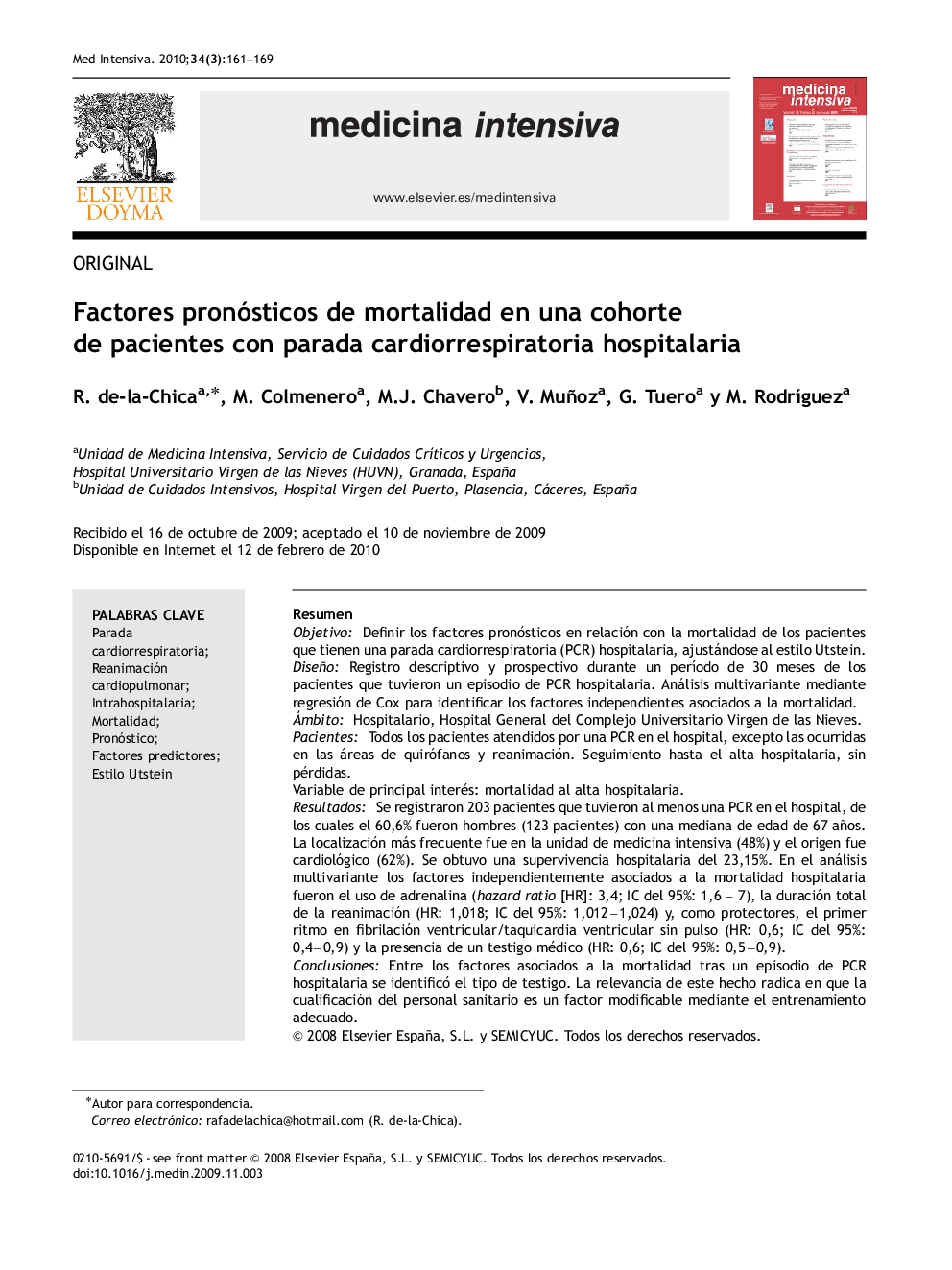| Article ID | Journal | Published Year | Pages | File Type |
|---|---|---|---|---|
| 3113571 | Medicina Intensiva | 2010 | 9 Pages |
ResumenObjetivoDefinir los factores pronósticos en relación con la mortalidad de los pacientes que tienen una parada cardiorrespiratoria (PCR) hospitalaria, ajustándose al estilo Utstein.DiseñoRegistro descriptivo y prospectivo durante un período de 30 meses de los pacientes que tuvieron un episodio de PCR hospitalaria. Análisis multivariante mediante regresión de Cox para identificar los factores independientes asociados a la mortalidad.ÁmbitoHospitalario, Hospital General del Complejo Universitario Virgen de las Nieves.PacientesTodos los pacientes atendidos por una PCR en el hospital, excepto las ocurridas en las áreas de quirófanos y reanimación. Seguimiento hasta el alta hospitalaria, sin pérdidas.Variable de principal interés: mortalidad al alta hospitalaria.ResultadosSe registraron 203 pacientes que tuvieron al menos una PCR en el hospital, de los cuales el 60,6% fueron hombres (123 pacientes) con una mediana de edad de 67 años. La localización más frecuente fue en la unidad de medicina intensiva (48%) y el origen fue cardiológico (62%). Se obtuvo una supervivencia hospitalaria del 23,15%. En el análisis multivariante los factores independientemente asociados a la mortalidad hospitalaria fueron el uso de adrenalina (hazard ratio [HR]: 3,4; IC del 95%: 1,6–7), la duración total de la reanimación (HR: 1,018; IC del 95%: 1,012–1,024) y, como protectores, el primer ritmo en fibrilación ventricular/taquicardia ventricular sin pulso (HR: 0,6; IC del 95%: 0,4–0,9) y la presencia de un testigo médico (HR: 0,6; IC del 95%: 0,5–0,9).ConclusionesEntre los factores asociados a la mortalidad tras un episodio de PCR hospitalaria se identificó el tipo de testigo. La relevancia de este hecho radica en que la cualificación del personal sanitario es un factor modificable mediante el entrenamiento adecuado.
ObjectiveTo define the prognostic factors related with mortality of patients who suffer cardiorespiratory arrest (CRA) in the hospital, according to Utstein style guidelines.DesignA descriptive and prospective study covering a 30-month consecutive period of all the patients who suffered at least one episode of in-hospital CRA. A Cox regression multivariate analysis was made to identify the independent factors associated with mortality.SettingA medical-surgical center in Hospital "Virgen de las Nieves" (HUVN), Granada (Spain).PatientsAll the patients attended due to CRA in the hospital, except for those occurring in the operating and recovery room areas. They were followed-up to hospital discharge.Main variablesMortality on hospital discharge.Results203 patients who suffered at least one cardiorespiratory arrest in the hospital, with a median age of 67 years and preponderance of male (60.6%). The most common location was in intensive care medicine unit (48%) and cardiac etiology (62%). Hospital survival rate was 23.15%. In multivariate analysis, strong predictors of mortality were administration of any dose of epinephrine during resuscitation maneuvers (OR 3.4; CI 95%. 1.6–7), total duration of resuscitation (HR 1.018; CI 95%, 1.012–1.024) and as protective factors the first ventricular fibrillation/ventricular tachycardia rhythm with no pulse (HR 0.6; CI 95%, 0.4–0.9) and witnessed by a doctor (HR 0.6; CI 95%, 0.5–0.9).ConclusionsThe type of witness was identified among the predictors of mortality on hospital discharge after an episode of cardiac arrest. This becomes important because the qualification of healthcare personnel can be improved through adequate training.
